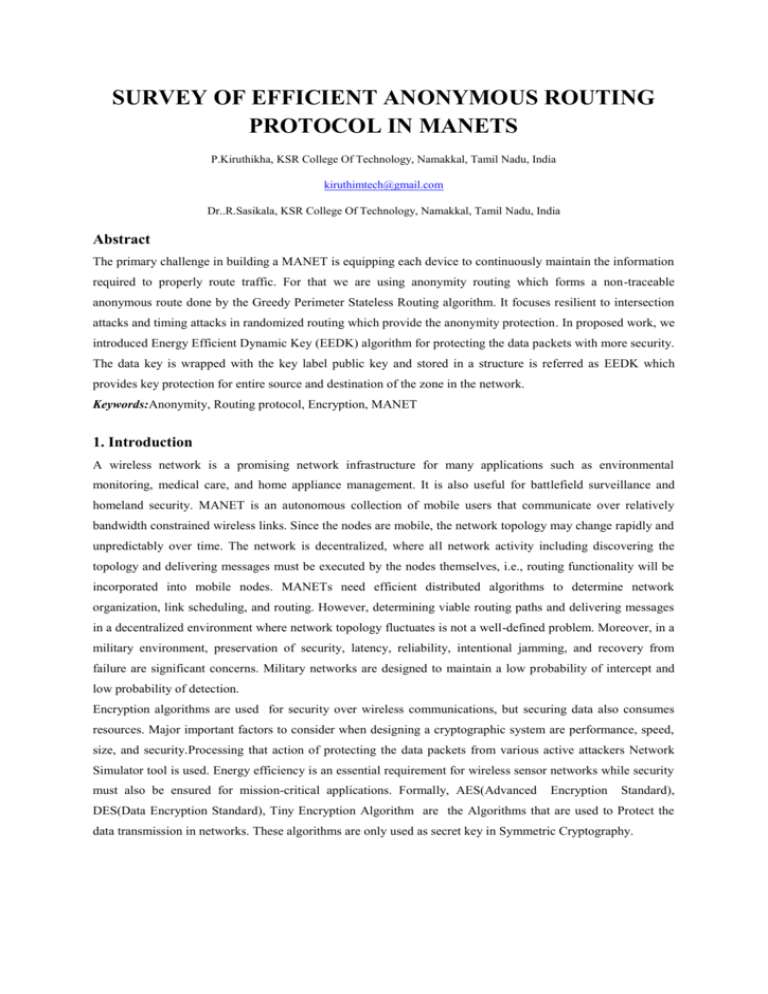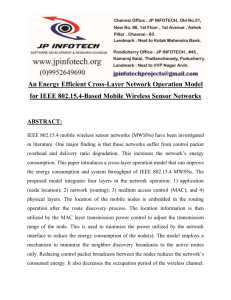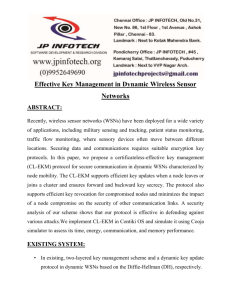survey of efficient anonymous routing protocol in manets
advertisement

SURVEY OF EFFICIENT ANONYMOUS ROUTING PROTOCOL IN MANETS P.Kiruthikha, KSR College Of Technology, Namakkal, Tamil Nadu, India kiruthimtech@gmail.com Dr..R.Sasikala, KSR College Of Technology, Namakkal, Tamil Nadu, India Abstract The primary challenge in building a MANET is equipping each device to continuously maintain the information required to properly route traffic. For that we are using anonymity routing which forms a non-traceable anonymous route done by the Greedy Perimeter Stateless Routing algorithm. It focuses resilient to intersection attacks and timing attacks in randomized routing which provide the anonymity protection. In proposed work, we introduced Energy Efficient Dynamic Key (EEDK) algorithm for protecting the data packets with more security. The data key is wrapped with the key label public key and stored in a structure is referred as EEDK which provides key protection for entire source and destination of the zone in the network. Keywords:Anonymity, Routing protocol, Encryption, MANET 1. Introduction A wireless network is a promising network infrastructure for many applications such as environmental monitoring, medical care, and home appliance management. It is also useful for battlefield surveillance and homeland security. MANET is an autonomous collection of mobile users that communicate over relatively bandwidth constrained wireless links. Since the nodes are mobile, the network topology may change rapidly and unpredictably over time. The network is decentralized, where all network activity including discovering the topology and delivering messages must be executed by the nodes themselves, i.e., routing functionality will be incorporated into mobile nodes. MANETs need efficient distributed algorithms to determine network organization, link scheduling, and routing. However, determining viable routing paths and delivering messages in a decentralized environment where network topology fluctuates is not a well-defined problem. Moreover, in a military environment, preservation of security, latency, reliability, intentional jamming, and recovery from failure are significant concerns. Military networks are designed to maintain a low probability of intercept and low probability of detection. Encryption algorithms are used for security over wireless communications, but securing data also consumes resources. Major important factors to consider when designing a cryptographic system are performance, speed, size, and security.Processing that action of protecting the data packets from various active attackers Network Simulator tool is used. Energy efficiency is an essential requirement for wireless sensor networks while security must also be ensured for mission-critical applications. Formally, AES(Advanced Encryption Standard), DES(Data Encryption Standard), Tiny Encryption Algorithm are the Algorithms that are used to Protect the data transmission in networks. These algorithms are only used as secret key in Symmetric Cryptography. 2 Related Work In recent years, several techniques have been proposed which is to achieve security in mobile adhoc networks. In this section, we survey the previously proposed algorithms for data transmission developed by the main researchers. Earlier work focused on Like other anonymity routing algorithms, ALERT is not completely bulletproof to all attacks. Also, ALERT cannot be applied to all network models. ALERT can be applied to Random Way Point model and Group Mobility Model. To prevent the occurrence of stronger and active attackers, we propose Energy efficient dynamic key Algorithm, where key is kept as secret till the end of data Transmission. 3. Survey of Active attacks An active attack attempts to change or destroy the data being exchanged in the network, thereby disrupting the normal functioning of the network. It can be classified into two categories external attacks and internal attacks. External attacks are carried out by nodes that do not belong to the network. These attacks can be prevented by using standard security mechanisms such as encryption techniques and firewalls. Internal attacks are carried out by compromised nodes that are actually part of the network. Since the attackers are already part of the network as authorized nodes, internal attacks are more severe and difficult to detect when compared to external attacks. 3.1 Wormhole Attack In wormhole attack, a malicious node receives packets at one location in the network and tunnels them to another location in the network, where these packets are resent into the network. This tunnel between two colluding attackers is referred to as a wormhole. 3.2 Black hole Attack In this attack, an attacker uses the routing protocol to advertise itself as having the shortest path to the node whose packets it wants to intercept. An attacker listen the requests for routes in a flooding based protocol. When the attacker receives a request for a route to the destination node, it creates a reply consisting of an extremely short route. If the malicious reply reaches the initiating node before the reply from the actual node, a fake route gets created. Once the malicious device has been able to insert itself between the communicating nodes, it is able to do anything with the packets passing between them. 3.3 Byzantine Attack In this attack, a compromised intermediate node or a set of compromised intermediate nodes works in collusion and carries out attacks such as creating routing loops, forwarding packets on non-optimal paths and selectively dropping packets which results in disruption or degradation of the routing services. 3.4 Session Hijacking Session hijacking is a critical error and gives an opportunity to the malicious node to behave as corrupted system. All the communications are authenticated only at the beginning of session setup. 3.5 Rushing Attack: On-demand routing protocols that use duplicate suppression during the route discovery process are vulnerable to this attack. An attacker which receives a route request packet from the initiating node floods the packet quickly throughout the network before other nodes which also receive the same route request packet can react. 3.6 Impersonation In this attack, a compromised node may get access to the network management system of the network and may start changing the configuration of the system as a super-user who has special privileges. An attacker could masquerade as an authorized node using several methods. It may be possible that by chance it can guess the identity and authentication details of the authorized node or target node, or it may snoop information regarding the identity and authentication of the target node from a previous communication, or it could disable the authentication mechanism at the target node. A man-in-the-middle attack is an example of impersonation attack. 4 Analysis of Key Management 4.1 Tiny Encryption Algorithm The Tiny Encryption Algorithm (TEA) is a symmetric (private) key encryption algorithm. It was designed for simplicity and performance, while seeking an encryption strength on par with more complicated and resourceintensive algorithms such as DES (Data Encryption Standard). TEA’s linear performance is a strength, since timing attacks can be effective. Tiny Encryption Algorithm is a short algorithm which will run on most machines and encipher safely . It uses a large number of iterations rather than a complicated program. It uses very little setup time and does a weak non linear iteration enough rounds to make it secure.It is hoped that it can easily be translated into most languages in a compatible way. It uses little set up time and enough rounds to make it secure. it can replace DES in software, and is short enough to write into almost any program on any computer. From academic research, one can learn of TEA’s relative merits. Understanding of TEA’s simplicity (ease of implementation), performance, and effectiveness. • Simplicity: TEA easy to implement in a variety of languages. •Performance: TEA’s design efficient. Its runtime speed compare with other similar block encryption algorithms. • Strength: TEA a cryptographically strong algorithm. Parameters DES Algorithm AES Algorithm Tiny Encryption EEDK Algorithm Encryption time(in 215.9359 99.871 231.4654 86.9171 183.5455 84.8904 193.5638 81.6492 sec) Decryption Time(in sec) Table 1: Comparison of Parameters Issue: There is a known weakness in the key schedule, so it is not recommended if utmost security is required. The more rounds (iterations), the more secure, but slower. 4.2 DES ALGORITHM File Size AES(time in sec) DES(time in sec) Tiny encryption EEDK Algorithm 512kb 24.68 34.64 38.17 22.71 1Mb 28.98 28.56 29.92 25.68 1.5Mb 23.38 30.47 32.13 21.35 2 Mb 26.71 28.45 30.45 26.10 Table 2: Comparison Based On Known Plaintext Issue: Key size is the main demerit in DES algorithm. Chips to perform one million of DES encrypt or decrypt operations available. Not designed for software and hence runs relatively slowly. Also the attacker can crack the Key space in 7 hours. So there is no security for long time. 4.3 AES ALGORITHM AES is a symmetric block cipher. This means that it uses the same key for both encryption and decryption. However, AES is quite different from DES in a number of ways and number of AES parameters depend on the key length. The four stages are as follows: Substitute bytes Shift rows Mix Columns Add Round Key Issue Even though it is easier, It need more processing. It require more rounds of communication as compare to energy efficient dynamic key algorithm. 4.4 EEDK Algorithm EEDK algorithm for protecting the data packets with more security. In that data key is wrapped with the key label public key and stored in a structure that is referred to as the Energy Efficient Dynamic Key that provide key protection for entire source and destination of the zone in the network. 5 conclusion Thus we conclude that DTSR is used to locate the correct relay node and sink node for data transmission To reduce the energy cost, nodes are active only during data transmission and the intersection of node creates a larger merged node. The Energy efficient dynamic Key Exchange is one of the more popular and interesting methods of key distribution. It is a public-key cryptographic system whose sole purpose is for distributing keys, whereby it is used to exchange a single piece of information. It enables that adhoc nodes can communicate each other securely. The key distribution to ad hoc nodes is done by means of two layer process. This paper process a key distribution scheme, based on intrusion detection method for using a data transmission from source to destination on the network. Thus It is based on high level security and more energy efficient data transmission on their network. ACKNOWLEDGMENT I would like to thank the authors who guided to finish this survey in an efficient manner. REFERENCES 1. Xiaoxin Wu Bharat Bhargava”AO2P: “Ad-Hoc On-Demand Position-BasedPrivate Routing Protocol” Computer Science Technical Reports. 2. Sk. Md. Mizanur Rahman, Masahiro MAMBO ”An Anonymous On-Demand Position-based Routing in Mobile Ad Hoc Networks” Proceedings of the 2005 Symposium on Applications and the Internet (SAINT’06) 2006 IEEE. 3. Imad Aad Claude Castelluccia Jean-Pierre Hubaux ,”Packet Coding for Strong Anonymity in Ad Hoc Networks” in Proceedings of IEEE WETICE, 2006. 4. Zhi Zhou and Kin Choong Yow “Anonymizing Geographic Ad Hoc Routing” for Preserving Location Privacy International Journal of Network Security, Vol.2, No.3, PP.210–218, May 2006. 5. Chao-Chin Chou, Student Member, IEEE, David S. L. Wei, Member, IEEE, C.-C. Jay Kuo,Fellow, IEEE and Kshirasagar Naik “An Efficient Anonymous Communication Protocol for Peer-to-Peer Applications overMobile Ad-hoc Networks” IEEE journal on selected areas in communications, vol. 25, no. 1, JANUARY 2007. 6. Karim El Defrawy and Gene Tsudik” PRISM: Privacy-friendly Routing In Suspicious MANETs (and VANETs)” IEEE Wireless Comm. Magazine, vol. 13, no. 5, pp. 8–15, 2006. 7. Xiaoyan Hong, Bo Gu, Qunwei Zheng”Strategies for Time based Multi-path Secure Information Disseminations in MANETs”, Austin, - 2008 IEEE. 8. Nitesh Saxena, Member, IEEE, Gene Tsudik, and Jeong Hyun” Secure Communication in Short-Lived MANETs” IEEE transactions on parallel and distributed systems, VOL. 20, NO. 2, FEBRUARY 2009. 9. Hidehisa Nakayama, Satoshi Kurosawa, Abbas Jamalipour, Yoshiaki Nemoto, and Nei Kato, “ A Dynamic Anomaly Detection Scheme for AODV-Based Mobile Ad Hoc Networks “ IEEE transactions on vehicular technology, vol. 58, NO. 5, JUNE 2009. 10. Siguang Chen, Meng Wu ”Anonymous Multipath Routing Protocol Based on Secret Sharing in Mobile Ad Hoc Networks” 2010 International Conference on Measuring Technology and Mechatronics Automation. 11. Karim El Defrawy, Member, IEEE, and Gene Tsudik, Senior Member, IEEE ALARM: “Anonymous Location-Aided Routing in Suspicious MANETs” IEEE transactions on mobile computing, VOL. 10, NO. 9, SEPTEMBER 2011. 12. Prateek Jain &Rupsha Bagchi”SMART: A Secure Multipath Anonymous Routing Technique” International Journal of Smart Sensors and Ad Hoc Networks (IJSSAN) ISSN No. 2248-9738 (Print) Volume-1, Issue-2, 2011. 13. Hiroki NishiyamaThuan Ngo, Nirwan Ansariand Nei Kato, “On Minimizing the Impact of Mobility on Topology Control in Mobile Ad Hoc Networks”, IEEE transactions on wireless communications, VOL. 11, NO. 3, MARCH 2012. 14. Jiajia Liu, Student Member, IEEE, Juntao Gao, Hiroki Nishiyama, Member, IEEE “Capacity and Delay of Probing-Based Two-Hop Relay in MANETs” IEEE transactions on wireless communications, accepted for publication 2011.







